Genshin Impact Aims for Eternity
Inazuma aimed for eternity and succeeded through its worldbuilding, poignant stories, and ability to weave reality with the otherworldly
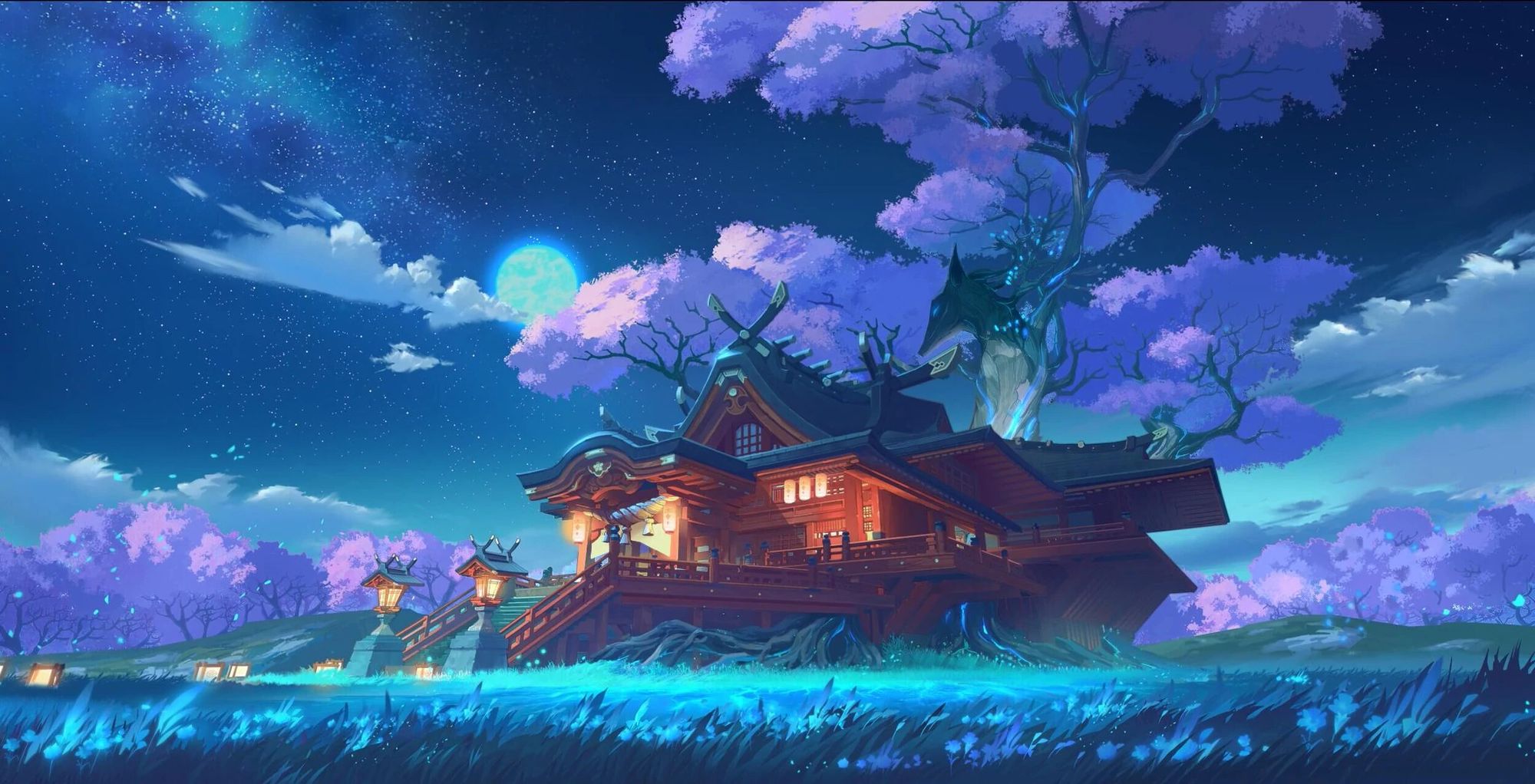
If you find yourself on Ritou, Inazuma’s port of entry, you will catch glimpses of a few towering mountains braided with purpling Yumemiru trees and fluttering sakura blossoms in the distance. People from all walks of Teyvat mill through Ritou's streets and prepare to travel deeper into Inazuma. Once upon a time, the space beyond the port crackled not only with electro-energy but with political restriction and turmoil, making it difficult for those not native to Inazuma to move deeper into the nation.
Last year, Genshin Impact introduced Inazuma as a nation cluttered with restrictions and fear. Despite the gorgeous violaceous-toned landscape and the multi-layered lore embedded across, this was a hostile nation. Arrows and debris pocketed the beaches with the detritus of battles. Outside the safety of the larger cities, looters and Nobushi readied to attack the unsuspecting, and the weather turned violent toward those who wandered. Yet despite Inazuma's nerve-wracking and daunting greeting, I couldn’t help but fall in love with this nation, one that snagged my heart and rightfully won my commitment.

Developers HoYoverse (previously known as miHoYo) made leaps and bounds in their design and narrative through Inazuma. Largely based on Japan and Japanese history, Inazuma became an opportunity for HoYoverse to introduce more mature themes than previously faced in the Traveler’s earlier adventures in Mondstadt and Liyue. Coupled with stronger world-building, environmental storytelling, and an array of unique characters, it’s hard not to admire Inazuma and the promise it holds for future stories and regions.
A Nation in Crisis
Players enjoyed the Irodori Festival this past April, a joyous occasion that commemorated the melding of different cultures, art, food, and ideas across Teyvat. The festival acted as a testament to the road of recovery Inazuma was now on. The street decorations, laughter, and paintings brightened the once somber and gray-washed port. It’s a sight that once was impossible to imagine, for just months prior, Inazuman streets sweltered with conflict and blood.
I knew right away that Inazuma wouldn’t be as welcoming to me as Liyue and Mondstat. Before I reached its shores, news of Inazuma’s Sakoku Decree whispered its way into Liyue’s port. Inazuma’s Shogun (the Electro Archon) shuttered its borders, making entering and leaving unthinkable. The outside world and change that can come from outside influences threatened the Shogun’s concept of ‘eternity’. This threat even extended to those with Visions. A mandated Vision Hunt Decree led to the confiscation of Visions from anyone who lived within Inazuma’s borders. The loss of a Vision was a blow to the soul, the former bearer drained of their passions. In Inazuma, dreams and ambition became synonymous with risk to stability, these abstract concepts in need of removal.
Source: YouTube.
If Mondstadt was the nation of freedom and Liyue a nation forging its own path, then Inazuma was a nation paralyzed.
HoYoverse pulled from history to not only act as the inspiration behind Inazuma’s aesthetics, but its social, economic, and political state. The Vision Hunt and Sakoku Decree acted as parallels to Japan’s series of reforms in the late sixteenth and early seventeenth centuries. To create stability and ‘unification’, the government set forth reforms that halted the flow of ideas and influence from its neighboring countries and beyond. Japan’s Sakoku Edict of 1635 forbade its citizens from leaving their territories. To do so, and find yourself later caught, led to harsh punishments, such as execution. Writers implied through characters like Atsuko — who left Inazuma during the Sakoku Decree’s implementation — that if she were to return, she would face similar punishment. Through newer characters like Kuki Shinobu, the Arataki Gang’s Deputy Leader, she revealed she could not return to Liyue to continue her studies because of the Decree.
"So if you see anyone wearing clothes similar to mine, they're probably from Inazuma. Please, if you see such a person, you cannot breathe a word of this to them, they cannot know I'm here. Please, I beg of you." - Atsuko
Japan not only isolated itself but self-excluded from the international stage during this time period. Under the Edict, foreigners could not enter freely unless provided with specific documentation. In Inazuma, we see the same. Merchants from other nations who would make the long trek to Inazuma or were already at Inazuma prior to the Decree found themselves unable to go beyond the entry port. To even gain further access to the port itself, ‘outlanders’ must go through Ritou’s processing center, facing an exorbitant fee. To add injury to insult, ‘outlanders’ faced frequent harassment and mistreatment during their stay.
Beyond the port fared no better...
From the moment I tumbled into Inazuma, I found myself thrown into a nation in crisis. In its effort to bring stability, it created instability.

The Price of Eternity
HoYoverse effectively used different islands encompassing Inazuma to show the impact of the civil war brewing in response to the Vision Hunt and Sakoku Decree. A resistance force led by Sangonomiya Kokomi, the Divine Priestess of Watsumi Island, faced the Shogun’s forces across Inazuma. However, what truly stood out to me was how this civil war reflected the islands’ landscape and people. Through a mix of environmental storytelling, side missions, and carefully crafted soundtrack, developers showed the disruption and impact warfare leaves on civilian populations. Yashiori Island stood out as one of the most notable examples of this topic.
Yashiori Island was no stranger to war. The island was once the battlefield between Orobashi (an ancient serpent-like god) and Ei (Shogun/Archon), the giant snake’s bones strewn across the island as a reminder. Orobashi’s energy — the Tatarigami — continued to linger after its death, with Inazumans developing wards in response to prevent harm and disaster.
When civil war later broke out, Orobashi loyalists within the Resistance forces (with the assistance of the Fatui) tampered with the wards that suppressed Orobashi’s lingering energy. With the wards gone, the island became plagued by natural disasters, illness, and bouts of insanity. Higi Village became ground zero and a vivid representation of how war can affect civilian populations.
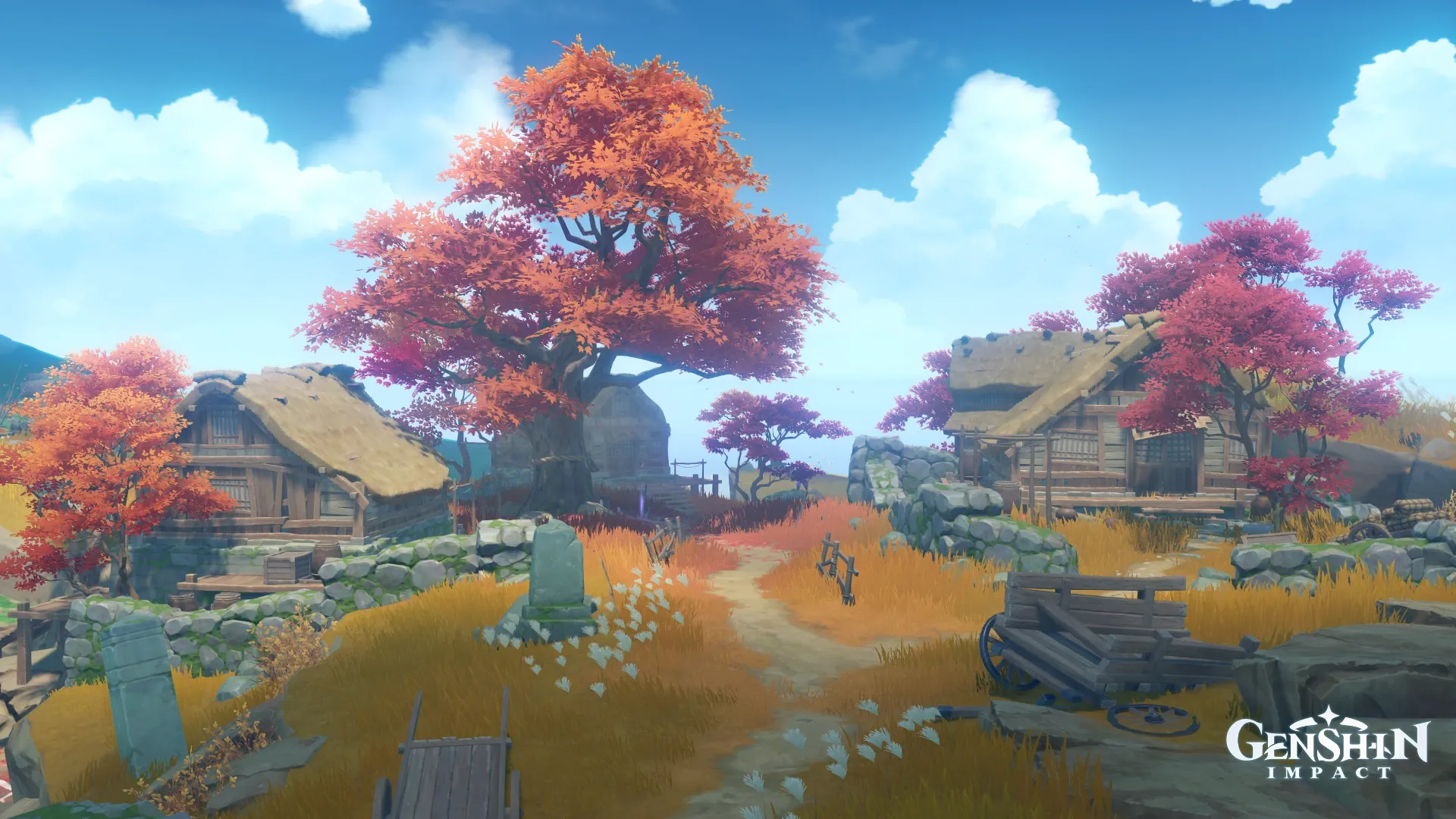
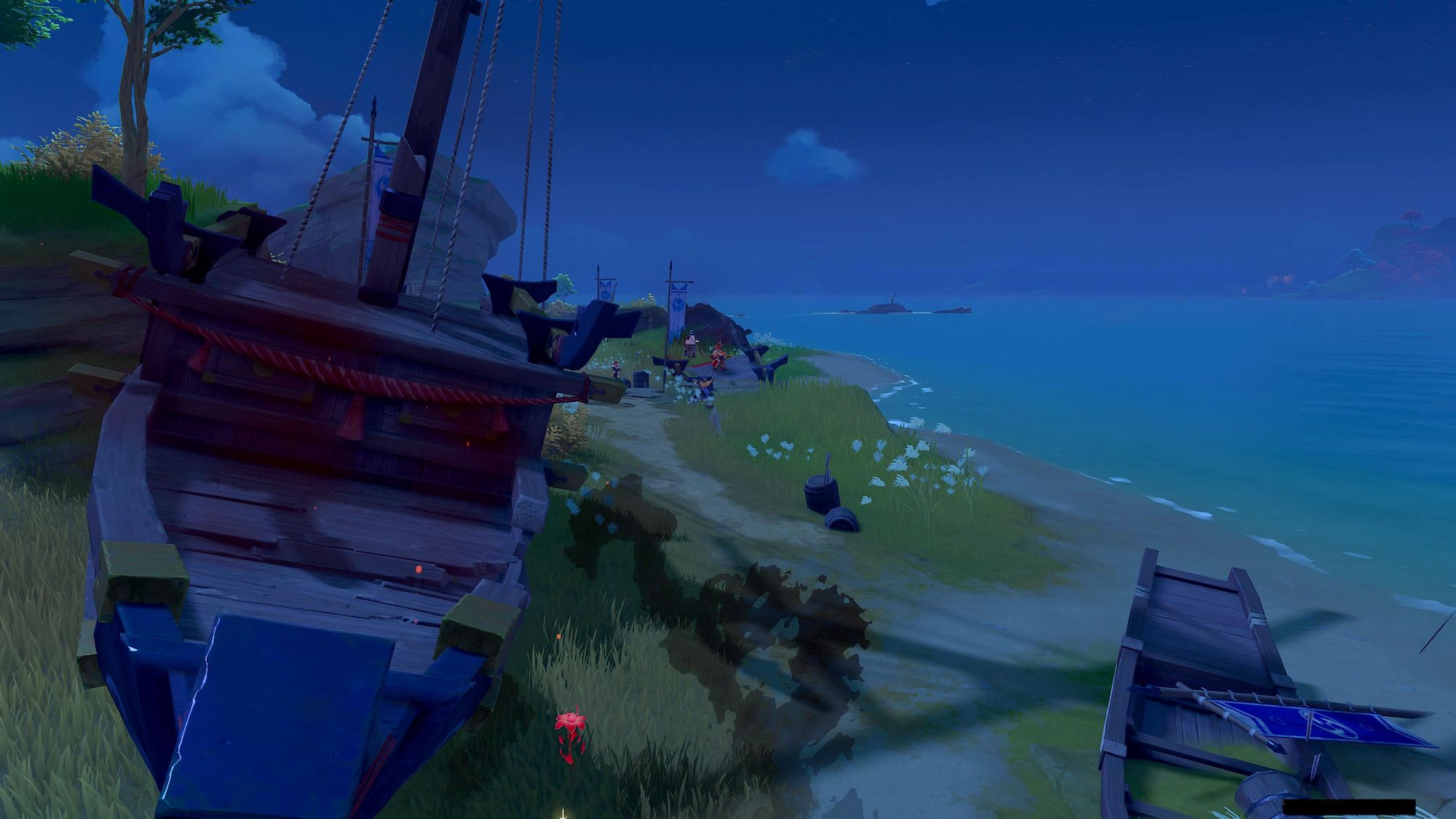
Examples of the impact of Inazuma's Civil War on civilians: (1) Impoverished and dying villages; (2) Battle Wreckage. Source: Author.
The village lay in disarray, its buildings unoccupied, tragedy quietly embedded in a series of side quests, landscape, and music. In the prior version, the song Ones Who Strive to Live cued up. A somber duet held by a shakuhachi and piano, occasionally sprinkled with sporadic notes of hope. That flickering ember of said hope lay in the local doctor, Yasumoto, who tried to heal Higi Village. Healing the village was a losing battle, as the Tatarigami’s disease was highly infectious and deadly to both the young and the old. It doesn’t help that, as the doctor strives for a solution, battles continued on across the island.
"Have a look for yourself. See what the city folks and Sangonomiya's people have done to us!" - Yasumoto
Yasumoto painted a picture to the Traveler of a village with a dwindling population facing poverty and severe illness (physical and mental), pointing out the lack of aid from the Resistance and Shogun’s forces. History has shown that when cities, villages, and other populated areas become battlefields, civilians represent most reported and unreported casualties. While the Resistance and the Shogun’s armies were not attacking civilians, their actions indirectly caused suffering. Sangonomiya’s Resistance forces in no way condoned the actions of radicals who embedded themselves into their forces, but they are still accountable for their actions. The same applies to the Shogun’s forces who used the island as their battlefield, leading to wreckage and a sweltering rise in crime thanks to opportunistic looters and pirates.
Through the world quest, Sinister Instruction, players witnessed the madness caused by the Tatarigami through a samurai called Washizu. He carried on him tattered notes that showed who died from illness or were slain by his violent delusions. Not too far off was a little boy, Chouji, who wandered the island alone. His mother became infected, but was mostly asymptomatic, carrying a bit of hope that she may survive. However, with no cure in sight, the doctor encouraged her to travel to Sumeru for help… I was baffled by this information. How can you travel to another nation while the Sakoku Decree is in effect? The answer was to attempt to plea for safe passage from the pirates and hope for the best.
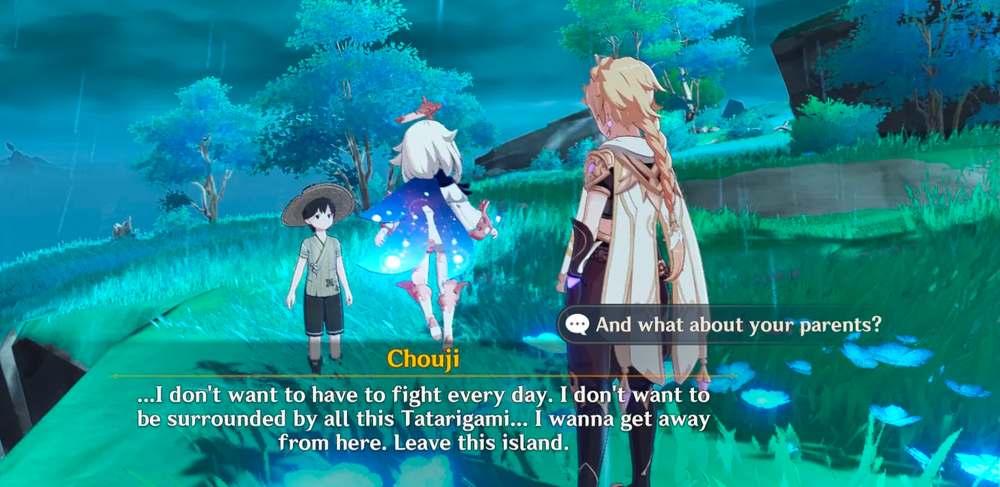
Chouji was none the wiser, believing his mom was searching for his father (who died, but Chouji refused to accept). While never explicitly stated what happened to Chouji’s mother, players can assume that she never made it because she either succumbed to her illness, was harmed by pirates, or was confronted by Shogun’s forces in the waters. It’s hard not to feel... icky as I walked away from a child who still tries to put on a facade. His story ended with him having enough funds saved to catch a ship to Snezhnaya once the Decree lifted. There is nothing left for him here on the island and in Inazuma as a whole. I felt helpless, waiting for the deus ex machina to suddenly fix this. It never came.
The luck that we wished to Chouji on this new ‘journey’ felt as empty as Higi Village itself.
Meanwhile, the doctor developed a potential cure thanks to the Traveler’s support. He shared he cannot administer this to anyone unless its effectiveness is tested, which requires him to first expose himself to the Tatarigami. This was his crucible and last-ditch attempt to fix this crisis with so few tools and support available. We never hear of the outcome, left only to hope the doctor survived. I can't help but wonder about the intention to replace the duet found in Ones Who Strive to Live with the chorus of string and wind instruments that once cued up only for the Musoujin Gorge, the heart of the Tatarigami. While the tune is just as beautiful and haunting, it felt more like the Tatarigami coiling in victory across the island.
I’m impressed with HoYoverse writers for showing players the price of war and eternity through its world-building and missions. That the islands that faced the brunt of the warfare continue to simmer with burning boats and opportunistic looters to this very day, speaks volumes. Healing a nation and its people in no way is an easy and quick feat, but we see those in the greatest of need receiving 'first aid' last.
Source: YouTube.
Isolation and Corruption
How did a nation like Inazuma succumb to such conflict? It began with fear. Without giving too much of the backstory away, there was once another archon who watched over Inazuma. 500 years prior, the Electro Archon Makoto (Baal), suddenly died. This loss devastated her twin sister, Ei (Beezelbub), who assumed the role of the next archon. Inazuma remained unaware of the loss of their god, assuming Ei was her sister.
As Ei struggled with the loss of her sister, she came to a harrowing conclusion: progress increases the chances of loss occurring. In order to eliminate the risk of tragedy, she must suspend Inazuma and herself in a frozen state. Ei isolated herself — physically and emotionally — in a mindscape of her making dubbed the Plane of Euthymia. Since she cannot effectively govern and watch her nation in this state, she created a puppet to fulfill her duties. That a puppet could serve as a reliable substitute showed immaturity and a lack of leadership experience on Ei’s part. This was a god in grief, choosing to hide rather than serve her nation. To no surprise, Ei’s self-isolation invited the risk she hoped to prevent.
"I've seen a nation strive forward, and lose everything to the Heavenly Principles. Perhaps only if time stands still will the lightning's glow never fade." - Ei
Isolation is a powerful and dangerous force, able to inflict damage on others and on oneself. Through the Inazuma arc, players see the theme of isolation played in a variety of ways: between Inazuma and its god, Inazuma and neighboring nations, and the populaces isolated because of civil war. Ei’s detached state from her nation proved to be debilitating, allowing agents of chaos to take root.
The Fatui assumed the role of said agents of chaos, arriving on Inazuma to destabilize the nation and create a market for their Delusions. Through bribery and manipulation, Fatui sowed the seeds of discord within the organizing bodies of Inazuma: the Tri-Commission. This led to the approval and implementation of the Vision Hunt Decree, which is another nod to Japanese history, specifically the Sword Hunt in 1588. The government forbade the lower class from owning weapons, with officials hunting down swords and later melting them to create a statue of Buddha (much like Visions embedded in the Statue of the Omnipresent God).
The goal of the Sword Hunt was to stop and prevent future peasant revolts and create stability. Even Ei, somewhat cognizant of the Fatui’s influence in Inazuman policies, approved of the Vision Hunt Decree. Both the Sword Hunt in 1588 and the Vision Hunt Decree in Inazuma acted as tools to limit successful uprisings. The Sakoku Decree that came after felt more like a way to ensure other nations wouldn’t intervene.
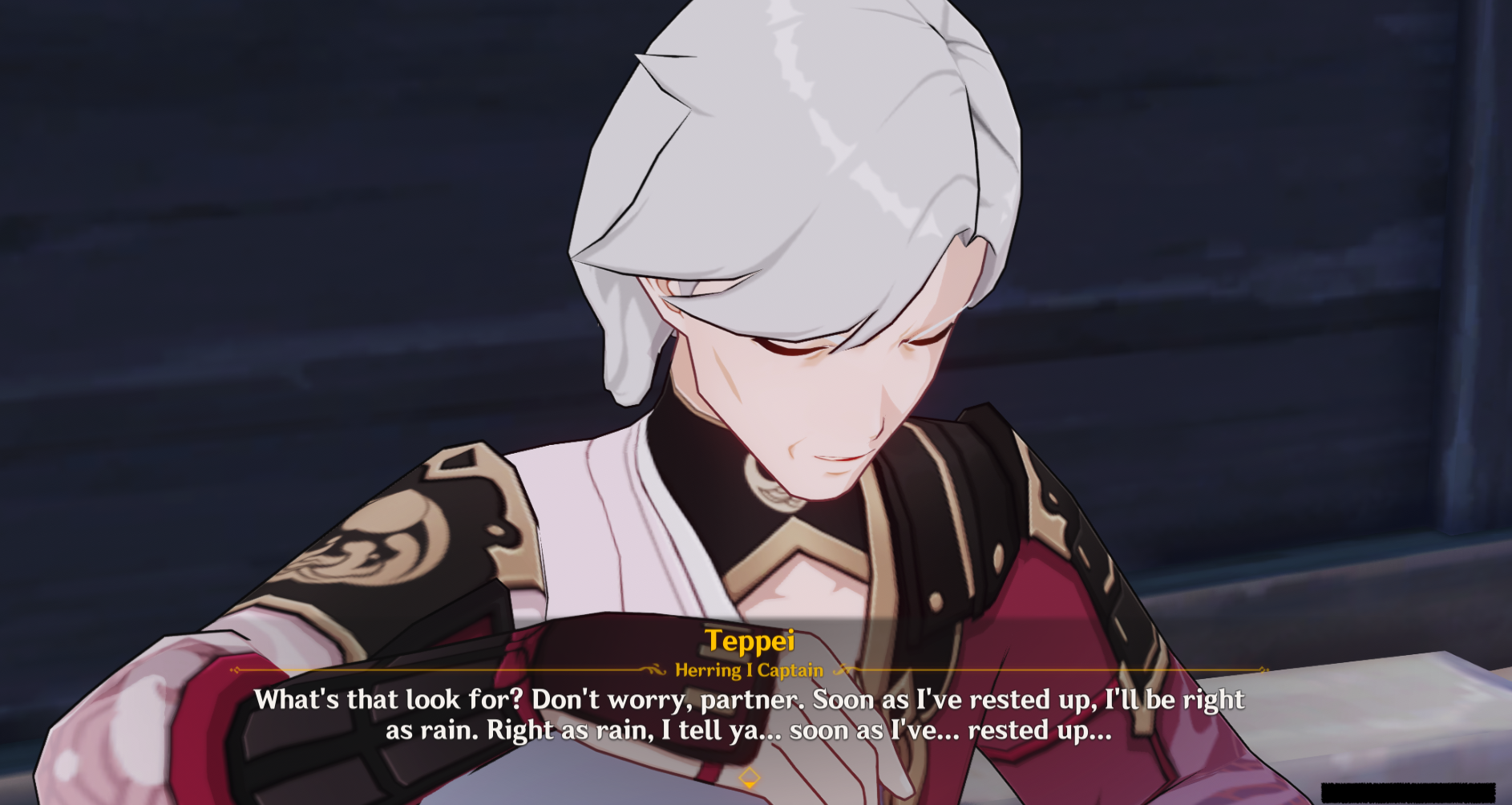
As the nation devolved into civil war, the Fatui fanned the flames of conflict. Both puppet and Ei fell victim to the omission of information and false reporting from corrupt officials of the true state of Inazuma. To further destabilize Inazuma, the distribution of Delusions wreaked havoc on Resistance forces and others. Delusions acted as a tremendous source of power to those who wear them, but it comes at a cost: one’s vitality. Many lost their lives through the usage of Delusions during the civil war.
There came points where each island felt infested by Fatui agents, somehow having a role – whether outwardly or behind the scenes – in upsetting the foundations of Inazuma. It's a great moment of irony when Ei later returned to her nation. In her attempt to preserve and stabilize Inazuma, her isolation resulted in its near collapse.
The Road to Recovery
HoYoverse received strong feedback in response to its initial display of Inazuma in a state of recovery. Developers began showing Inazuma in its post-civil war state through story quests. Story quests are a mixed bag in Genshin Impact: You either experience a meaningful series of events with a character or it’s more of a ‘fluff’ hangout. Reflections of Morality was Ei’s story quest that was filled with moments that felt dismissive of the Inazuma’s plight and the series of problems that emerged during the conflict. The Electro Archon checking out light novels and chugging dango milk in no way was as informative or poignant as, say, Zhongli’s story quest. While there was a moment of Ei solving a dispute with two clans, it felt more like an opportunity to show off the archon in battle rather than develop her as a character.
Transient Dreams, the second portion of Ei’s story quest, showed players Ei finding her place and purpose as a protector of Inazuma and its people. HoYoverse took players' feedback to heart and presented a quest that offered insight into Inazuma’s wellbeing around the time of Khaenri’ah's fall. Monsters ravaged the nation, memories of those who fought or tried to flee emerging from the roots of the Sacred Sakura that stretch across Narukami Island. It's heartbreaking and we see Ei demonstrating incredible respect and care for the lingering echoes of the lives lost. It ends with Ei challenging the puppet version of herself. This became a symbolic battle between her prior self (one plagued with rigidity) and her current self (a budding leader ready to embrace change). The quest not only was well-balanced with combat and lore but acted as an opportunity to flesh out and develop the archon.
"A battleground... One where I shall sever ties with the past and take the first steps into the future." - Ei
With Inazuma’s archon now making strong efforts to protect the nation, we currently see different groups within Inazuma pitch into the effort. In Sangonomiya Kokomi’s story quest, Dracaena Somnolenta Chapter, we see the Resistance leader hold peace talks with Shogunate forces in finding a peaceful resolution moving forward together. However, there are those who are wary of peace or seen having a difficult time embracing that the conflict is over (thanks to Fatui meddling, again). It’s a reminder that the road to true recovery bears potholes and if the conviction for peace isn’t strong enough, Inazuma will find itself stuck in one.
Source: YouTube.
The recovery introduced characters like Kamisato Ayato, the head of the Yashiro Commission. He's a character I instantly gravitated to the moment he appeared on screen, his reveal reminiscent of Humphrey Bogart’s Rick Blaine in Casablanca. Here we see Ayato with his back turned to the shogi board, skillfully maneuvering across the board without needing to see it. It’s a clever way of demonstrating he’s a skilled tactician. Through hard work, grit, and strategy, he won back the favor of the Kamisato Clan after his parents' deaths. With command of the Shuumatsuban, a group of highly trained ninjas, he strives to maintain balance within the Tri-Commission and, most importantly, protect those he cares for. When one threatens the peace of Inazuma or his family, he’s absolutely lethal.
He’s a perfect compliment to Kamisato Ayaka, his younger sister, who Thoma, the Kamisato’s housekeeper and Inazuma’s fixer, introduced us to when we initially arrived. While confident in his sister’s abilities, she’s someone who Ayato has shielded from the uglier side of the Tri-Commission. I’m a real sucker for family members who want nothing more than to protect their loved ones, but are not stifling.
The two siblings worked together in tandem with the other organizing bodies to host the Irodori Festival that went live this past April. This festival served two purposes: to celebrate Inazuma’s literary legacy and act as an invitation to other nations across Teyvat with the Sakoku Decree being finally abolished. Players learned about Inazuma's literary legacy, specifically the Five Kasen, a group of talented singers and poets. While poetry is no longer the craze in Inazuma as it once was in its heyday, light novels have taken the nation by storm. Authors and artists from within and beyond Inazuma’s shores participated in competitions and activities. It was a touching event where we see the friends and allies we’ve made during our journeys interact with each other. It was a true melding of cultures and ideas, signaling that Inazuma is on the right track.
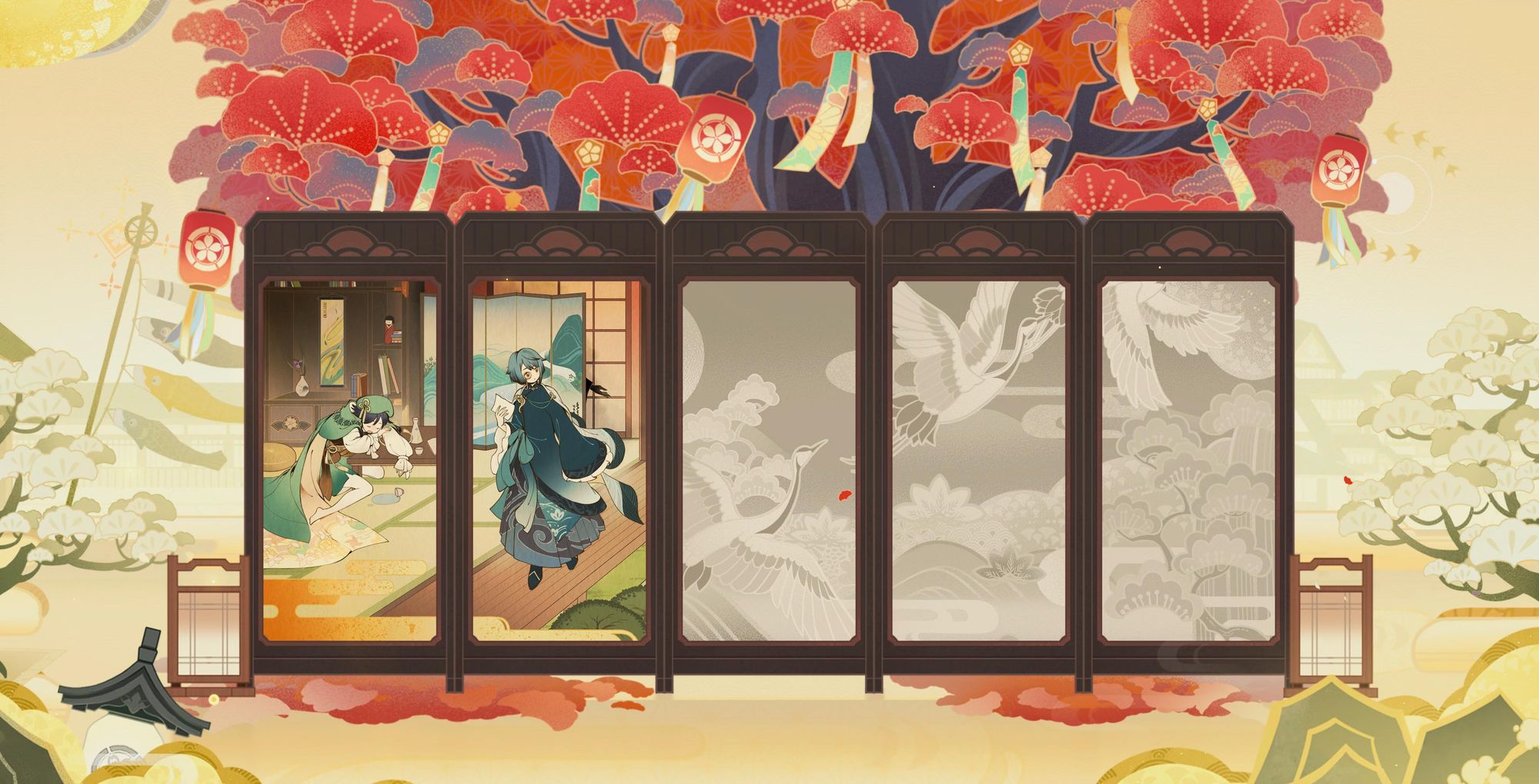
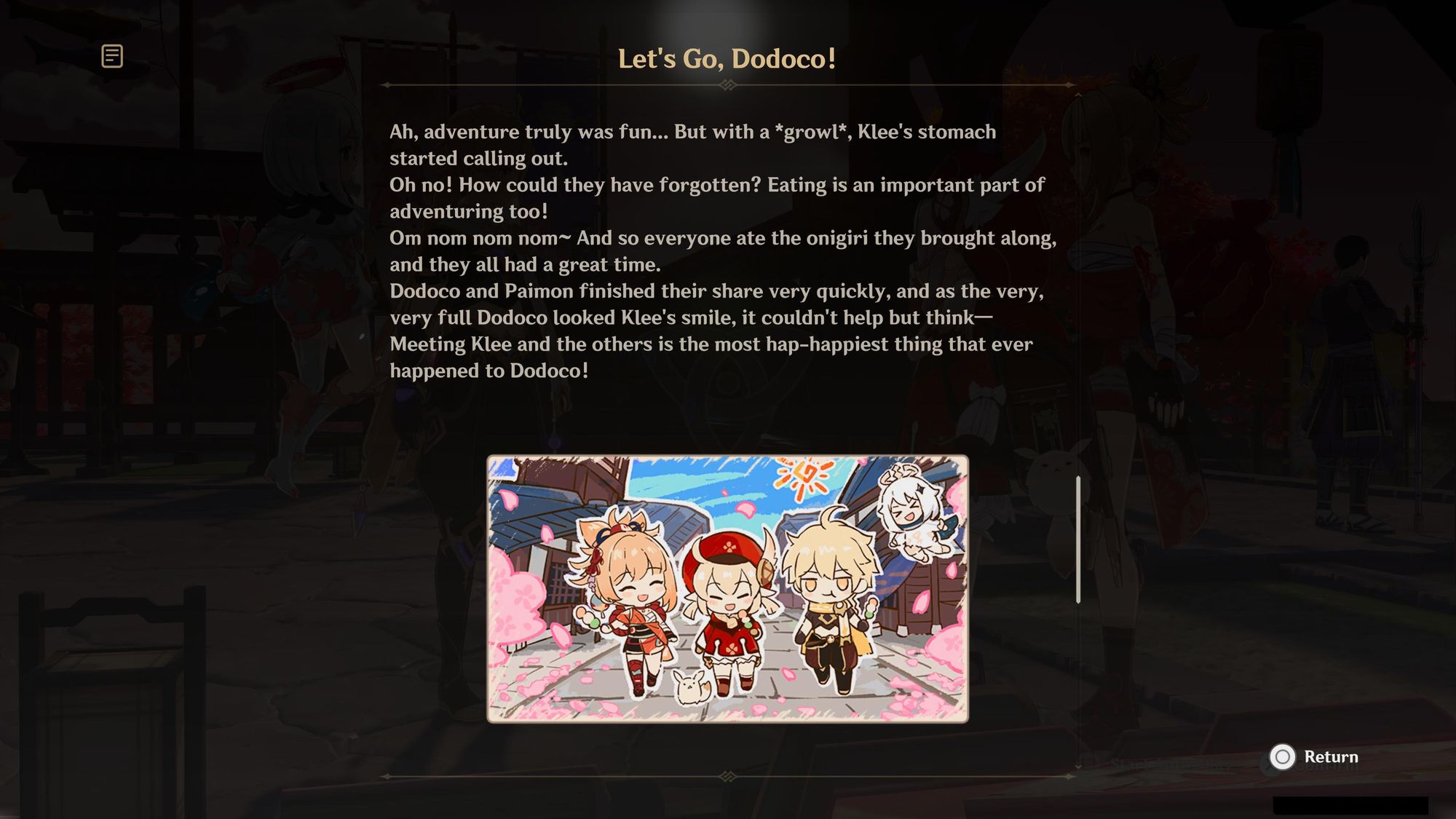
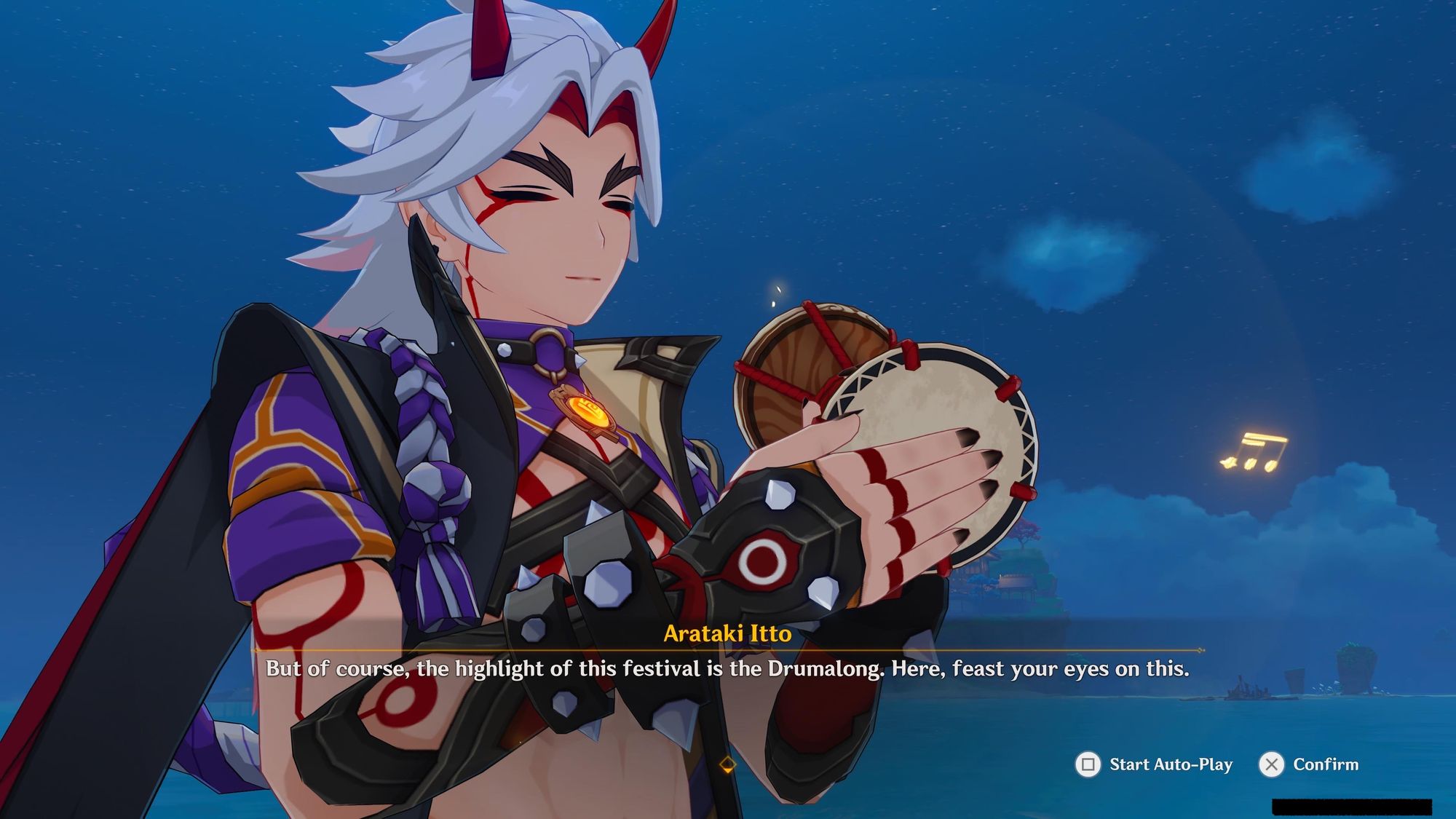
From left to right: (1) Each new day within the festival revealed a portrait of one of the Five Kasen courtesy of Albedo; (2) Story collaboration between Klee and Yoimiya; (3) Itto's overpriced hand drum for the Drumalong Festival. Source: Author.
Even the most recent Almighty Arataki Great and Glorious Drumalong Festival is a sign that Inazuma's health is improving. Not so sure about Itto’s wellbeing and his knack for ending up in trouble or overpaying for a small hand drum, but the encouragement from our favorite Inazuman characters for his small festival was endearing.
However, I still cannot help but think of Yashori and the other islands. Improvements feel isolated to Narukami and Watsumi Island. The other islands continue to suffer in the aftermath of civil war (Yashiro Island) or from unnatural events (Seirai Island) caused by — as I like to dub it — supernatural neglect. I would argue that the absence of recovery isn’t intentional by HoYoverse writers, but it is noticeable. The more urbanized portions of Inazuma are healing compared to the more rural areas of Inazuma. However, I’m still hopeful we will see more. We can see through character chapters that Inazuma’s recovery is a continual work-in-progress.
Where Myth and Reality Meet
What makes Inazuma memorable besides its compelling stories is its fusion between Japanese aesthetics and Teyvat’s magic. Sakura blossoms swirl in the air and are obtainable after zapping them with electricity. Tanukis, Japanese raccoon dogs, dance and shape-shift before you. Here was a region where the barrier between myth and reality was paper-thin, leaving me with the same feeling of awe and apprehension that I felt when hiking Jueyun Karst for the first time.
HoYoverse writers made it so the events that took place on Inazuma intertwined with their otherworldly counterparts. There is such an incredible wealth of unique stories, magic, and locations thanks to how expansive Inazuma is.
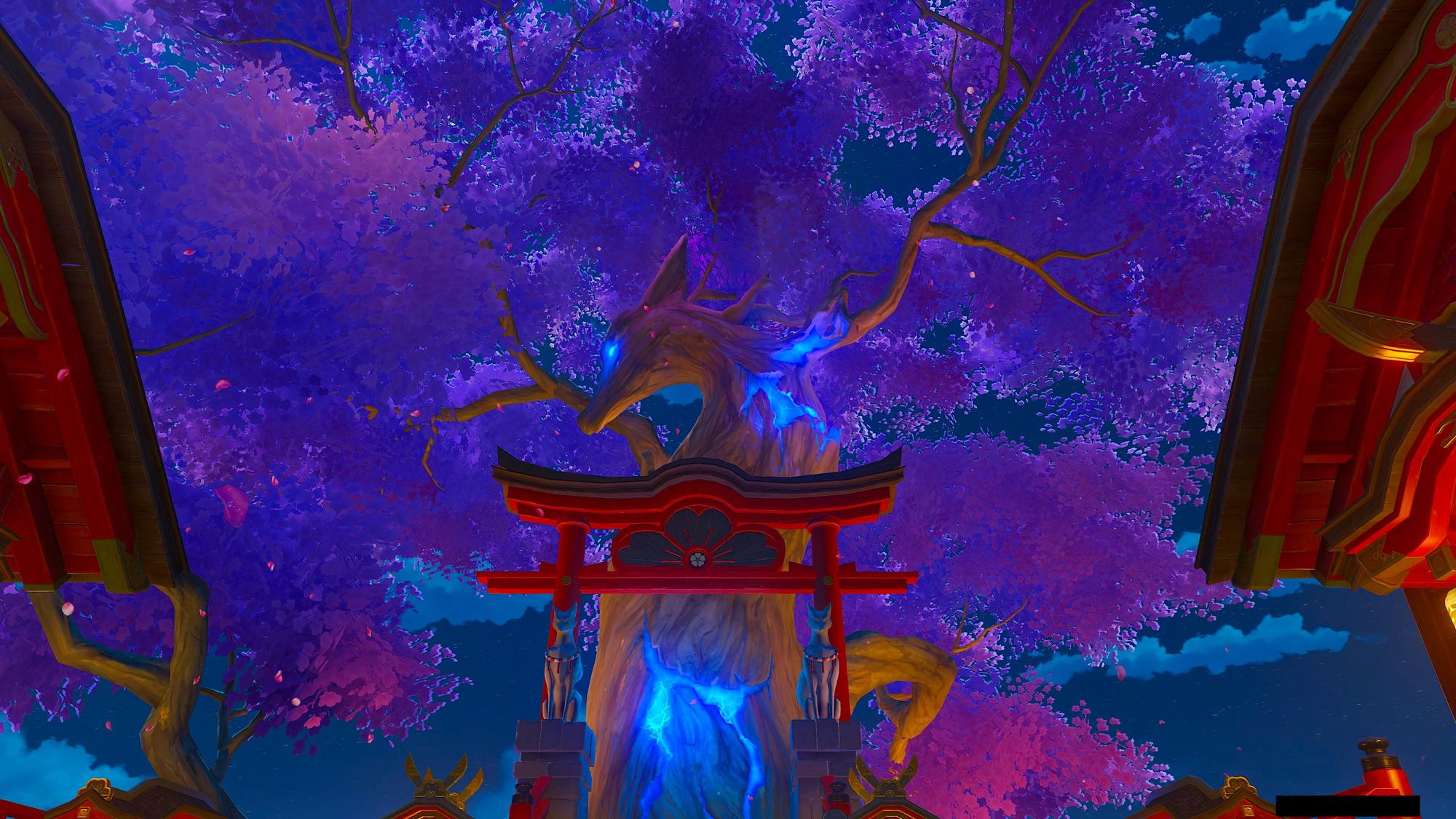
One of my favorites is the story behind the Sacred Sakura which you can visit at the Grand Narukami Shrine. Visiting the shrine requires a steep hike up a mountain through multiple torii gates and watchful kitsune. The kitsune-esque sakura tree observes Inazuma from above, its tree’s roots stretch all across the nation. The Sacred Sakura represents the power of Inazuma’s archon and is a symbol of the archon’s protection.
In the Sacred Sakura Cleansing Ritual story, a shrine maiden wearing a kitsune mask requested our help in purifying the Sacred Sakura. The roots accumulated filth and require a specific cleansing ritual every 60 years. Writers scatter the legend of Kitsune Saiguu across conversations and later story quests, the kitsune who was once worshipped as a goddess and was an ally to Ei. Rumor was that Saiguu’s familiars turned into sleeping statues, waiting for her return, their stone's surface holding memories. With the Memento Lens, we discovered correct sacred words and obtained needed wards for the ritual.
The ritual was a unique way of introducing us to the magic-infused nation of Teyvat. It led us through Narukami’s Chinju Forest, its trees rife with mystery and magic, sunlight blocked out and leading to a chilly blue mist swirling about. There we met the bake-danuki, Ioroi, previously sealed in a stone statue after being discovered breaking kitsune statues out of misunderstanding. The story ended with a harrowing battle against a 'tumor' that could summon corrupted memories in the shape of warriors.
It felt fitting that the Sacred Sakura was in peril, reflecting the tumultuous state of Inazuma. The Sacred Sakura will, also, make a reappearance in Ei's most recent story quest as she carves her own path as Inazuma's archon.

I often saw throughout the islands that supernatural issues often coincided with social and political ones. On Seirai Island, specifically, one of the prevailing issues was neglect.
Seirai Island sits like a deep bruise on the map. It was on this island the Asase Clan built a shrine to suppress the lingering hatred from the felled Thunderbird hundreds of years ago. The Thunderbird destroyed Tsurumi Island and laid waste to Seirai Island before being killed by Ei. The shrine acted as a last line of defense, keeping remnants of the Thunderbird’s power at bay. However, the Head Priestess of the shrine later unsealed the wards due to conflict with the Shogun. This led to the Thunderbird’s power being released, plaguing the island with violent storms and leading to the priestess’ disappearance.
This event left a hostile island faced with perpetual thunderstorms in its wake, survivors forced to flee their homes. All that now roamed the island were hostile machines and creatures. Yet the Asase shrine remained, watched by Neko, a talking cat who assumed the role of ‘Provisional Head Priestess’. Neko waited and continues to wait for the Head Priestess to return, often talking fondly about her. However, nearly five hundred years had passed… Even when faced with the truth of the state of the island, Neko will continue to wait by the shrine, forever devoted to her long-lost priestess. All I could think of throughout Neko's story was Hachiko, the loyal dog who waited for its owner by the train, unaware of their dear friend's passing. Cue the tears!

A favorite recent addition to Inazuma was the introduction of Enkanomiya, an island that had sunk into the deep abyss underneath Watasumi Island in the past millennia. Plunged into darkness, the citizens of Enkanomiya struggled to survive until the serpent god, Orobashi, later became Enkanomiya’s ruler. To combat the darkness, they developed a false sun, the Dainichi Mikoshi. It not only provided light but protected citizens from the Bathysmal Vishaps. The sun could switch between ‘day’ and ‘night’, even altering the architecture across the shattered island.
It’s gloomy in Enkanomiya as it floats in this dark space beneath the very ocean itself. Deep-sea vegetation sprouts out of the ground and massive manta rays glide across the space above. Just like the soundtrack that accompanies Enkanomiya, the space is beautiful and cold, but empty. It’s a graveyard of fluttering banners and spirits. You can move through this disjointed landscape and speak with shades of those who once lived in Enkanomiya.
"I dreamed of using the Dainichi Mikoshi to wash away the darkness, but I did not then know that it was the greed and desire within human hearts that was the all-devouring night everlasting." - Aberaku
The most heartbreaking of stories was that of the Sunchildren. Nobles would persuade Enkanomiyans to worship the Dainichi Mikoshi and have a child sit as the ‘Sunchild’ who would rule over the land. Nobles would manipulate and prey on the naivety of each new Sunchild to fulfill their political goals. The Enkanomiya people loathed and blamed the Sunchildren for the island’s failings, even though they were aware themselves of the manipulation taking place. To ensure that the child would never rise against these corrupt nobles, the nobles would incinerate the ruling child when they reached a certain age in a formal ceremony. These morose and grim stories litter the landscape, our only consolation being that our actions can give rest to these shades.
Enkanomiya lore, also, brought more information regarding the existence of dragons and vishaps (reptilian creatures believed to become dragons after an extended period). Specifically, the Bathysmal Vishaps have adapted and evolved based on their need. We’ll hear different theories and stories shared by other characters, at times conflicting with each other. For example, Enjou shared that the Bathysmal Vishaps have learned to adapt and imitate humans. However, Kokomi stated that theory is nothing more than fiction. She shared the legend of the Vassals of Watasumi (half-human, half-reptile) who were Orobashi’s familiars. It’s implied that a character we interacted with in Enkanomiya, Tsumi, was the last of the Vassals. While I’m unsure of whose information is the correct one, it’s certainly made me more intrigued about our reptilian-eyed doctor in Liyue, Doctor Baizhu.
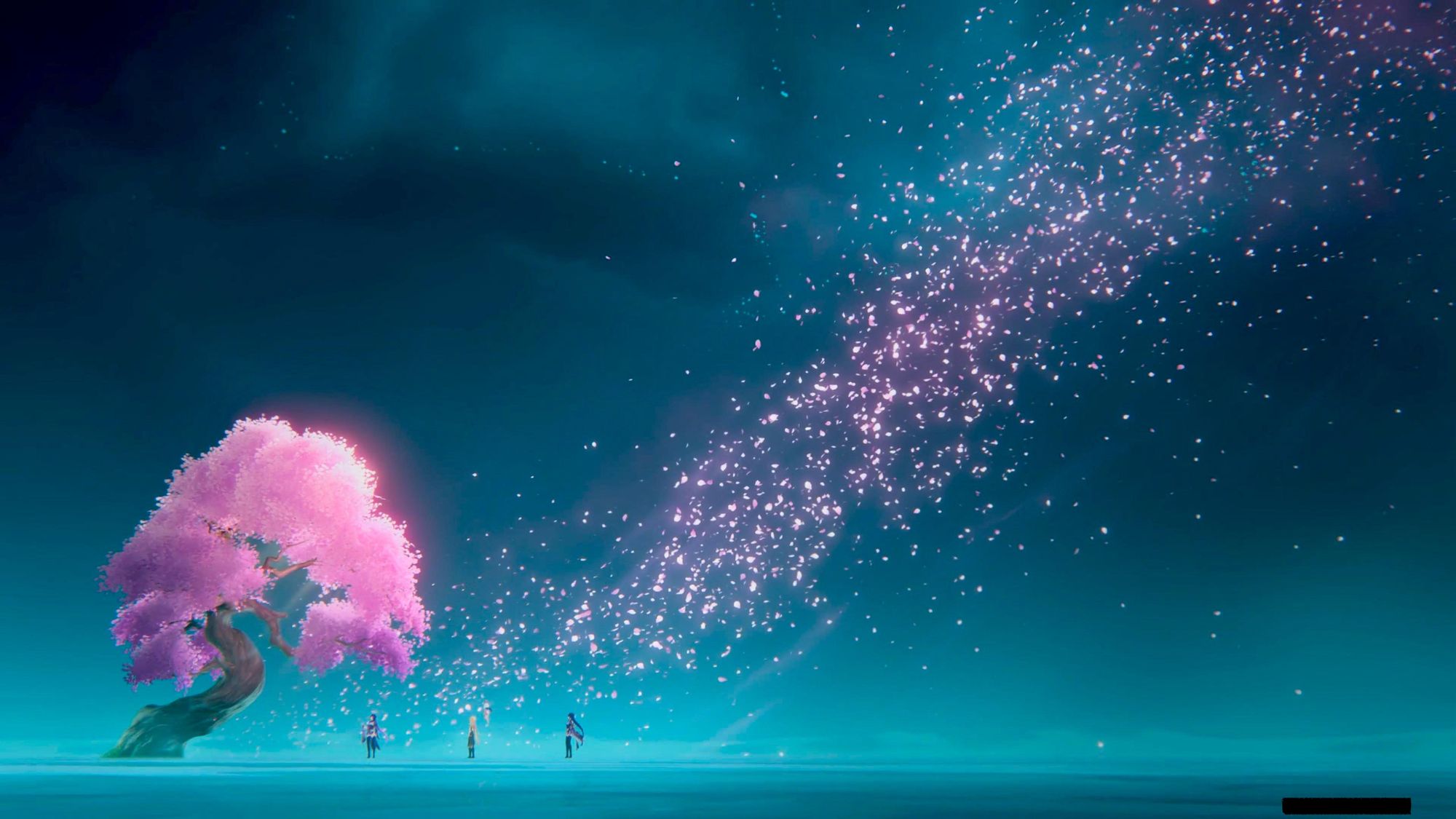
Final Thoughts
Inazuma aimed for eternity by becoming unforgettable with its worldbuilding, poignant stories, and ability to weave reality with the otherworldly. This piece alone in no way fully encompasses the incredible collection of adventures, locations, and characters you can engage with across Inazuma. With how well players have responded to Inazuma and its slew of serious themes, I anticipate that this will continue to carry through. While I’m partial to tear-jerkers, writers do a great job balancing emotionally charged scenes with moments of levity.
What I’m truly excited about is the HoYoverse team turning to previous locations to develop them and the characters further. HoYoverse already delivered with the addition of the Chasm in Liyue. It feels like a page taken from Inazuma, with players given the opportunity to explore the depths of the nation. The quests that emerged from within have given incredible life and a new air of mystery to this once familiar region. The most recent Archon quest, Hidden Dreams in the Depths, featuring Xiao and new characters, Yelan and Shinobu, is a testament to HoYoverse’s growth in world-building and character development.
As Genshin Impact continues to grow with fresh stories, I’m forever content island-hopping across Inazuma and watching the sakura trees blossom with it.
